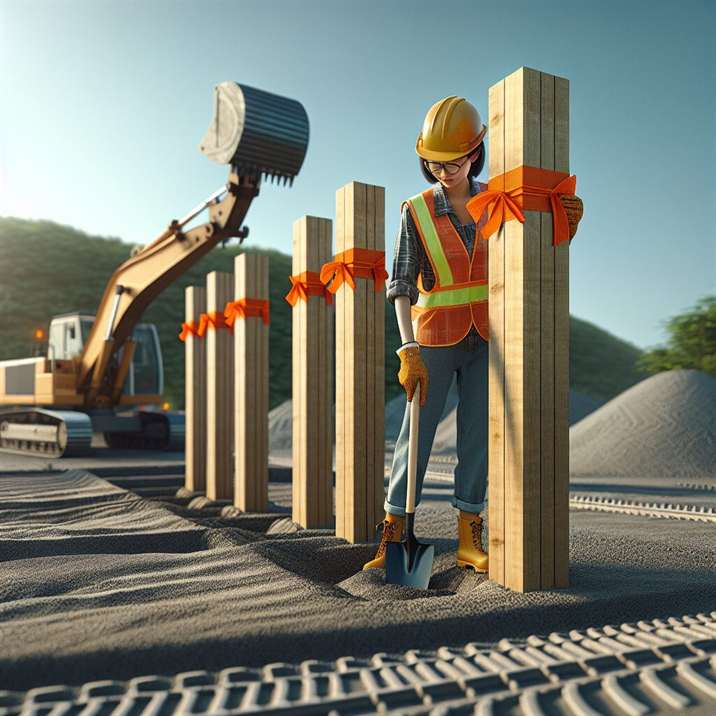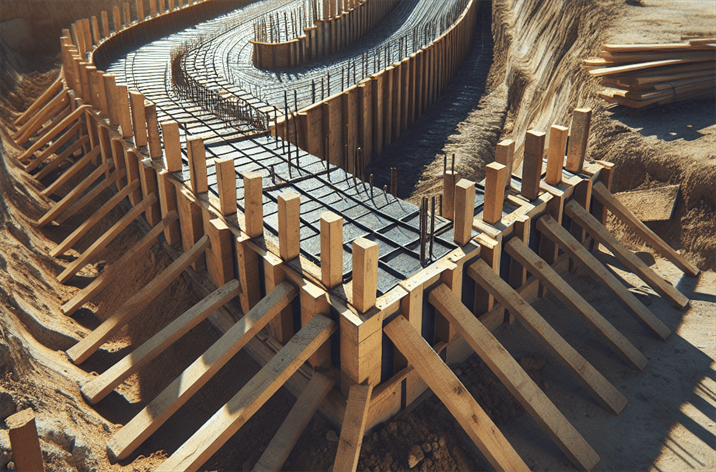Benefits Of Wooden Stakes In Construction: Why They Matter
Introduction
Did you know that wooden stakes have been a staple in construction for centuries? Their enduring presence in the industry speaks volumes about their effectiveness and versatility. As the construction landscape evolves, there’s an increasing emphasis on sustainable materials, and wooden stakes have garnered renewed interest. In this article, we’ll dive deep into the benefits of wooden stakes in construction, exploring their historical significance, modern applications, and future prospects.
In recent years, sustainable building practices have taken center stage, pushing the construction industry to seek eco-friendly alternatives. Wooden stakes not only align with these practices but also offer a myriad of benefits that can enhance the quality and efficiency of construction projects.
By the end of this article, you will have a comprehensive understanding of the benefits of wooden stakes in construction, their practical applications, potential challenges, and innovative trends shaping their use in the industry.
What are Wooden Stakes in Construction?
Definition
Wooden stakes are pointed wooden posts used to mark boundaries, provide support, and assist in the layout of construction sites. They serve multiple purposes, including establishing property lines, indicating grading levels, and ensuring accurate measurements during the building process. Their simplicity and effectiveness have made them a go-to solution for contractors and landscapers alike. For more information on eco-friendly wooden stakes for sustainable construction, visit Eco-friendly wooden stakes for construction.
Historical Context
The use of wooden stakes in construction dates back to ancient civilizations. Early builders utilized simple wooden pegs to outline structures, ensuring that their designs were executed with precision. Over the centuries, these rudimentary tools have evolved, but their fundamental purpose remains unchanged. From the pyramids of Egypt to modern skyscrapers, wooden stakes have played a crucial role in the construction process.

Importance of Wooden Stakes in Construction
Today, wooden stakes are more relevant than ever. As the construction industry shifts towards sustainable practices, these stakes present a green alternative to plastic or metal markers. They are biodegradable, often sourced from renewable forests, and can be repurposed or recycled after use. Additionally, with the increasing emphasis on eco-friendly materials, the demand for wooden stakes continues to rise. Check out our detailed guide on durable wooden stakes for construction for more information.
Wooden Stakes in Construction in the Context of Landscaping and Site Preparation
Wooden stakes are not limited to traditional construction projects. They are widely used in landscaping and site preparation, where they help outline garden beds, mark planting areas, and define pathways. Their versatility makes them an essential tool across various sectors within construction and landscaping. Explore how wooden stakes play a significant role in landscaping projects on our Landscaping with wood stakes.
Key Players or Contributors
Several organizations and manufacturers have contributed significantly to the development and use of wooden stakes in construction. Companies like Stan’s Stakes provide high-quality, durable wooden stakes that are essential for both small and large-scale projects. Their commitment to sustainable sourcing practices has positioned them as leaders in the industry. Learn more about their approach to sustainable construction materials at Sustainable wooden stakes.
How Do Wooden Stakes in Construction Work?
The Mechanics of Wooden Stakes in Construction
Wooden stakes function as physical markers that facilitate the accurate layout of construction sites. They help delineate boundaries, guide excavation efforts, and serve as structural supports during various phases of construction. By anchoring key points in the terrain, these stakes allow for precise measurements and alignments, which are crucial for the integrity of any construction project. Discover the best practices for utilizing wooden stakes in construction at Best practices for stakes and lath in construction.
Technological Foundations of Wooden Stakes in Construction
While wooden stakes may seem straightforward, their application often involves sophisticated technology. Modern construction practices utilize advanced surveying tools and techniques to ensure that wooden stakes are placed accurately. This includes GPS technology and laser levels, which enhance the precision of layout work. Sustainable sourcing practices also play a crucial role, ensuring that the wood used for stakes is harvested responsibly and ethically.
Real-World Applications of Wooden Stakes in Construction
Wooden stakes find a variety of applications in the construction industry. Here are a few examples:
- Foundation Laying: Wooden stakes help outline the dimensions of a building foundation, ensuring precise placement and alignment.
- Fencing: They serve as critical supports for fencing projects, providing stability and structure.
- Landscaping: In landscaping, wooden stakes are used to mark planting areas and define garden layouts.
Case Studies/Examples of Wooden Stakes in Construction in Action
Consider a recent residential project where wooden stakes were utilized to define the boundaries for a new home. The contractor accurately placed stakes to outline the foundation, ensuring that every aspect of the layout was correct. This not only saved time but also reduced the risk of costly mistakes. Explore more about the best stakes for construction projects at Best stakes for construction purposes.
Benefits and Drawbacks of Wooden Stakes in Construction
While wooden stakes offer numerous advantages, it’s essential to consider potential drawbacks:
Advantages:
- Sustainability: They are biodegradable and often sourced from renewable materials.
- Cost-Effective: Wooden stakes are generally more affordable than their metal or plastic counterparts.
- Versatility: They can be used in various applications, making them a multi-functional tool.
Limitations:
- Durability: Wooden stakes may not be as durable as metal stakes, particularly in extreme weather conditions.
- Maintenance: They may require regular inspection and replacement, especially in high-traffic areas.
The Benefits of Wooden Stakes in Construction
Why Use Wooden Stakes in Construction?
The benefits of wooden stakes in construction are manifold, making them an indispensable tool for contractors and builders. Here are some of the key advantages:
- Eco-Friendly Choice: As the construction industry embraces sustainable practices, wooden stakes provide a greener alternative to synthetic materials. They are biodegradable and can be sourced from sustainably managed forests, aligning with modern eco-friendly construction principles. For more insights on sustainable wooden stakes, visit Sustainable stakes and lath for construction.
- Cost-Effectiveness: Wooden stakes are often more affordable than alternatives like metal or plastic stakes. This cost efficiency can significantly impact overall project budgets, allowing contractors to allocate resources more effectively.
- Easy Handling and Installation: Wooden stakes are lightweight and easy to handle, making installation a straightforward process. They can be quickly driven into the ground with minimal tools, streamlining project timelines.
- Versatile Applications: From marking boundaries to supporting temporary structures, wooden stakes can be utilized in various contexts, including landscaping, grading, and foundation work. Their adaptability makes them a valuable asset across multiple construction phases. Explore the Best wooden stakes for fencing projects for more details.
Support for Local Economies
Choosing wooden stakes sourced from local suppliers supports regional economies and promotes sustainable forestry practices. This connection helps foster community development and environmental stewardship.
Challenges and Considerations
While the benefits of wooden stakes in construction are clear, it’s essential to address potential challenges as well. For instance, wooden stakes may not be the best option for every project. In areas with extreme weather conditions, more durable materials might be required. Additionally, the maintenance of wooden stakes, including periodic inspections and potential replacements, can be time-consuming. For more information, refer to our guide on Best practices for placing site grading stakes on uneven terrain.
Future Trends in Wooden Stakes in Construction
Innovations in Material Sourcing
As the demand for sustainable materials continues to rise, innovations in sourcing practices will play a pivotal role in the future of wooden stakes. Expect to see more emphasis on reclaimed wood and responsibly harvested timber, which can further enhance the eco-friendliness of wooden stakes.
Enhanced Durability and Treatment
Advancements in wood treatment processes will lead to more durable wooden stakes that can withstand harsh weather and environmental conditions. This evolution will make wooden stakes even more appealing in a broader range of applications, including those that require longevity and resilience.
Integration with Technology
The integration of technology in construction is undeniable, and wooden stakes will not be left behind. Smart stakes equipped with sensors could provide real-time data on soil conditions, moisture levels, or structural integrity, enhancing the efficiency and accuracy of construction projects.
Growing Popularity in Landscaping
As landscaping trends shift towards sustainable practices, the use of wooden stakes will likely increase. They can be used creatively in garden designs, erosion control, and other eco-friendly landscaping projects.
Conclusion
The benefits of wooden stakes in construction are numerous and varied, making them an indispensable tool for contractors and builders alike. Their eco-friendly nature, cost-effectiveness, and versatility underscore their relevance in modern construction practices. As sustainability continues to shape the industry, wooden stakes will undoubtedly remain a vital component.
Whether you are planning a large-scale construction project or a simple landscaping endeavor, integrating wooden stakes into your toolkit can enhance both efficiency and effectiveness. Embracing these age-old tools in contemporary practices not only honors tradition but also paves the way for a more sustainable future in construction.
For those interested in exploring high-quality wooden stakes, check out our selection of affordable wooden stakes for construction use and take a step towards sustainable building practices today!
Resource Links:
1. Woodworking Network – Discusses the advantages of using wooden stakes in construction projects, including sustainability and cost-effectiveness.
2. The Constructor – Explores various benefits of wooden stakes, such as environmental impact and ease of use.
3. Builder Online – Highlights the practicality and durability of wooden stakes in construction applications.

